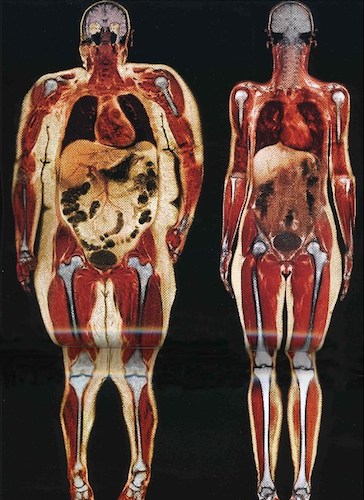*Disclaimer: Elephant Journal articles represent the personal views of the authors, and can not possibly reflect Elephant Journal as a whole. Disagree with an Op-Ed or opinion? We’re happy to share your experience here. This website is not designed to, and should not be construed to, provide medical advice, professional diagnosis, opinion or treatment to you or any other individual, and is not intended as a substitute for medical or professional care and treatment. For serious.
~
The common wisdom is that if you are overweight you are unhealthy, and if you are thin, you are healthy. But new research points to just how dangerous being skinny can be—if you are a skinny fat person that is.
The medical term for this is “MONW” or metabolically obese normal weight, which I prefer to refer to as being a skinny fat person. It means you are under lean but over fat—not enough muscle and too much fat (especially belly fat.) It seems it is better to be fat and fit than thin and out of shape.
While we know that 68% of American population is overweight, and that most have diabesity—being somewhere on the continuum of pre-diabetes to type 2 diabetes—the shocking news from a study published in the Journal of the American Medical Association is that nearly one in four skinny people have pre-diabetes and are “metabolically obese.”
What’s worse is that if you are a skinny fat person and get diagnosed with diabetes, you have twice the risk of death than if you are overweight when diagnosed with diabetes. Perhaps having that extra muscle on your body from having to carry around those extra pounds protects you.
Studies on teenagers found that 37% of the skinny kids had one or more signs of pre-diabetes such as high blood pressure, high blood sugar, or high cholesterol. Wait—almost four out of ten of normal weight kids are pre-diabetic?
It is bad enough that one third of kids are overweight or obese in America, but now it appears that only about 20% of children in America are healthy—in other words eight out of 10 children in America are overweight or have pre-diabetes or type 2 diabetes.
In my medical practice I see this all the time. Jim came in for a “wellness check up” and felt happy about his weight. His BMI (or body mass index) was 22 (normal is 18 to 24.)
He never seemed to gain weight and felt he could “tolerate” a diet that included lots of bread, pasta and sugar. He liked his two sodas a day and a few glasses of wine at night. He walked but didn’t do much vigorous exercise or weight training.
When we looked under the hood we found he had a blood sugar of 117 mg/dl (pre-diabetes) and triglycerides of 350 mg/dl, and an HDL of 35 mg/dl. His blood pressure was 148/96 mmHg (normal is less than 110/75 mmHg.)
And when we measured his insulin levels after taking a sugar drink, they were sky high. Insulin is the real culprit here—it is the fat storage hormone. It stores belly fat and leads to hormonal and metabolic changes that cause muscle loss and inflammation, furthering the vicious cycle of pre-diabetes or type 2 diabetes—whether you are skinny or fat.
He was shocked to find out he had severe pre-diabetes and was a ticking time bomb for a heart attack, stroke and even cancer and dementia. I treated Jim exactly the same way as my patients with type 2 diabetes.
Get the Right Tests
So how do you know if you are a skinny fat person?
There are a few criteria you can use that can help you identify yourself as having diabesity or being “skinny fat” including family history of type 2 diabetes or early onset of heart disease (heart attack in relative under 50 years old,) or even looking down and see a little pot belly. And if you are of Asian or Indian descent, you can get diabesity at a much lower body weight.
There are some important blood tests that you should have your doctor do:
- Fasting blood sugar or glucose (normal less than 90 mg/dl)
- Triglycerides (normal less than 100 mg/dl)
- HDL (good cholesterol (normal greater than 60 mg/dl)
- Blood pressure (normal less than 120/80, ideal less than 115/75)
But there are a few special tests your doctor may not do that you should insist on that tell the true story and help to detect diabesity much earlier. They are:
- An insulin response test (what most doctors call a glucose tolerance test but with the addition of insulin measurements) that will:
- Measure glucose (blood sugar) and insulin levels while fasting and one and two hours after a 75 gram glucose drink (the equivalent of two sodas.)
- Glucose should be less than 90 mg/dl fasting and never go above 120 mg/dl at one and two hours. Over 140 mg/dl is prediabetes and over 200 mg/dl is type 2 diabetes.
- Insulin should be less than 10 fasting and never go above 25 or 30 after the sugar drink. Many with diabesity and skinny fat people can have levels over 50, 100 or even 200.
- NMR Lipid Particle Test (by LipoScience performed by LabCorp)
- This measures the size and number of cholesterol particles. You should have less than 1000 total LDL particles and less than 500 small LDL particles.
- Most cholesterol tests just measure the total amount like 200 mg/dl but the particle test is much better at predicting risk for heart disease.
- When you are a skinny fat person with diabesity you have too many particles and they are the small dense dangerous kind.
The Cure for the Skinny Fat Syndrome
The cure for the skinny fat syndrome is the same as the cure for someone who is overweight with diabesity. It is the subject of my latest book, The Blood Sugar Solution.
It is quite simple actually.
- Eat a Low-Glycemic Load Diet—lean animal protein (chicken, fish,and eggs), nuts, seeds, beans, vegetables, fruit and small amounts of non-gluten grains.
- Power Up with Protein—start the day with protein and at each meal. This makes your metabolism run hotter and cuts hunger. Incorporate eggs, protein shakes, nuts, seeds, chicken or fish.
- Don’t Drink Your Calories—no sodas, juices, sweetened drinks and no more than three to four glasses of wine or alcohol a week with meals.
- Avoid the Deadly White Powder or Flour—including gluten-free flour products. Even whole grain flour acts like sugar in your body.
- Beware of Frankenfood—factory-made foods are often science projects with fake ingredients including MSG (which causes ravenous hunger and is hidden as “natural flavoring”,) high fructose corn syrup, artificial colors, preservatives and chemicals.
- Eat from the Right Plant—if it was made in a plant stay away, if it was grown on a plant it is probably okay.
- Get an Oil Change—eat omega-3 fat rich foods including sardines and wild salmon and avoid refined and processed vegetable oils except olive oil.
- Get Going and Get Strong: both cardio and strength training are key. Cardio builds fitness and improves metabolism and strength training builds muscle so you won’t be a skinny fat person.
- Take Supplements: they grease the wheels of your metabolism and help burn calories and balance blood sugar. A good multivitamin, fish oil (EPA/DHA,) and vitamin D do the trick for 95% of people.
- Protect Sleep Time: sleep deprivation alters metabolism and increases cravings for carbs and sugar. Sleep is sacred. Make your bedroom a sleeping temple and stay there for seven to eight hours a night.
These latest facts are alarming because those of us who think we get a pass because we are thin need to take a second look at our health. You can still be skinny and sick and be metabolically obese—which in the end may be even more dangerous.
The good news is that this is a solvable problem. Getting tested and working through the 10 steps to being a skinny healthy person is a scientifically proven, effective way to change your biology quickly. And the side effects are all good—increased energy, better sleep and even better sex! For more information on how to reverse diabesity see The Blood Sugar Solution to get a free sneak peak.
To your good health,
Mark Hyman, MD
~
References:
Carnethon MR, De Chavez PJ, Biggs ML, Lewis CE, Pankow JS, Bertoni AG, Golden SH, Liu K, Mukamal KJ, Campbell-Jenkins B, Dyer AR. Association of weight status with mortality in adults with incident diabetes. JAMA. 2012 Aug 8;308(6):581-90.
Ribeiro JP, Schaan BD. Physical activity advice only or structured exercise training and association with HbA1c levels in type 2 diabetes: a systematic review and meta-analysis. JAMA. 2011 May 4;305(17):1790-9. Review.
Relephant Read:
Reset Your Fat Burners
~
Love elephant and want to go steady?
Sign up for our (curated) daily and weekly newsletters!
Editor: Rachel Nussbaum
Photo: Imgur
Ready to join?
Hey, thanks so much for reading! Elephant offers 1 article every month for free.
If you want more, grab a subscription for unlimited reads for $5/year (normally, it's $108/year, and the discount ends soon).
And clearly you appreciate mindfulness with a sense of humor and integrity! Why not join the Elephant community, become an Elephriend?
Your investment will help Elephant Journal invest in our editors and writers who promote your values to create the change you want to see in your world!
Already have an account? Log in.
Ready to join?
Hey, thanks so much for reading! Elephant offers 1 article every month for free.
If you want more, grab a subscription for unlimited reads for $5/year (normally, it's $108/year, and the discount ends soon).
And clearly you appreciate mindfulness with a sense of humor and integrity! Why not join the Elephant community, become an Elephriend?
Your investment will help Elephant Journal invest in our editors and writers who promote your values to create the change you want to see in your world!
Already have an account? Log in.
Ready to join?
Hey, thanks so much for reading! Elephant offers 1 article every month for free.
If you want more, grab a subscription for unlimited reads for $5/year (normally, it's $108/year, and the discount ends soon).
And clearly you appreciate mindfulness with a sense of humor and integrity! Why not join the Elephant community, become an Elephriend?
Your investment will help Elephant Journal invest in our editors and writers who promote your values to create the change you want to see in your world!
Already have an account? Log in.
 Share on bsky
Share on bsky


Read 4 comments and reply